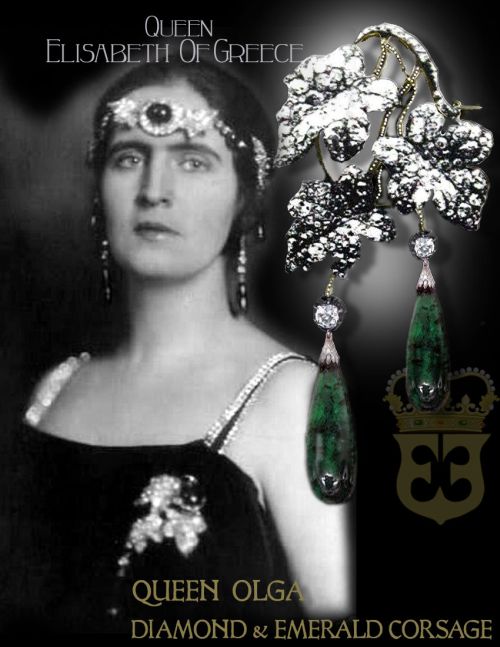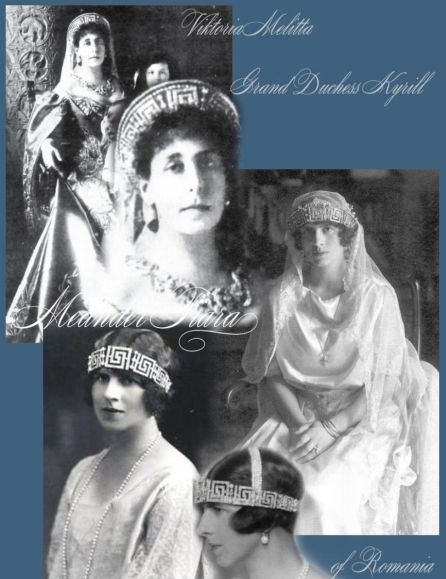The Pearl and Diamond Tiara | Empress Marie Alexandrovna | Gift from the Tsar Alexander II| later known the Vladimir Tiara
Archival records give an idea of the gift. In addition, the inventory in 1838 showed that on January 2, 1842, the following was delivered to the jeweler Bolin from the Diamond Room of the Winter Palace: „Diamonds in the pieces (unset) of paper available from the converted units. Four diamonds weighing 3 Karat (a tiara with pearls to use January 2, 1842), the same polished 64 ‚/ short. From this lot polished faces of the same weight 22 ‚/ 32 fold on a tiara with pearls January 2, 1842, from the bodice with Pearls. A diamond weighing 1 3/32 times from the range. Purchased for a tiara with pearls January 2, 1842″ * notes 423
Nevertheless, the legendary diamond tiara, made in 1842, including diamonds , was worth 87,478 rubles. 424 *notes Corresp.Bolin;Zimin

siehe A.Zimin Buch Geschenke des Zaren AlexanderII 2013
The exquisite „Grand Duchess Vladimir tiara,“ a cherished adornment frequently graced upon the late Queen Elizabeth II of Great Britain, holds a captivating historical narrative. Delving into the annals of time, we discover that this regal treasure’s lineage traces back to an era imbued with imperial splendor.
Originally procured by Queen Elizabeth’s illustrious grandmother, Queen Mary, the tiara was acquired in 1921 from none other than the daughter of Grand Duchess Maria Pavlovna of Russia. This acquisition came to pass subsequent to the clandestine removal of the tiara from the tumultuous grips of revolutionary Russia. Long-held assumptions suggested that it had been bestowed upon Maria as a wedding gift during her union with Grand Duke Vladimir in 1874.
However, the Grand Duchess Vladimir tiara, it turns out, is steeped in an even more venerable history. Imbued with an air of aristocracy, this magnificent artifact was, in fact, crafted three decades prior, in a bygone era.
Its inception took place during a momentous occasion when the illustrious Princess of Hessen by Rhine, the future Empress Maria Alexandrovna, bestowed upon the world their firstborn son, Grand Duke Nicholas Alexandrovich Romanov, in the year 1843. It was made by the court jeweller Bolin.
Though Nikolay’s earthly sojourn was brief, the tiara continued its journey through time. Following the passing of Empress Maria in 1880, this resplendent crown of diamonds and pearls gracefully transitioned into the possession of her third son, the esteemed Grand Duke Vladimir. A testament to its enduring allure, the tiara underwent a subtle transformation in 1924, facilitated by the deft hands of Queen Mary. Adorned with the renowned Cambridge emerald pear shaped pedants, the tiara now stands as a resplendent amalgamation of precious gemstones, an irrefutable symbol of regal refinement.
Thus, the captivating tale of the „Grand Duchess Vladimir tiara“ weaves a tapestry of nobility and historical intrigue. Through its many custodians and transformations, this timeless artifact has transcended eras, gracefully adorning the heads of queens and captivating the hearts of all who gaze upon its majestic splendor.
Maria Alexandrovna (Russian: Мария Александровна), born Princess Wilhelmine Marie of Hesse and by Rhine (8 August 1824 – 3 June 1880), was Empress of Russia as the first wife of Emperor Alexander II.
Marie was the legal daughter of Ludwig II, Grand Duke of Hesse, and Princess Wilhelmine of Baden. Marie was only 14 years old when Tsesarevich Alexander Nikolaevich fell in love with her while he was traveling to Western Europe. She arrived in Russia in September 1840 and converted to the Eastern Orthodox Church under the name Maria Alexandrovna, when she married Alexander the following April.
Maria was known for her intellect. However, she suffered from tuberculosis from 1863 and spent long stays in southern Europe to avoid harsh winters, which worsened after the death of her eldest son Nicholas Alexandrovich. She was also the mother of Marie Alexandrovna, the Duchess of Edinburgh and Saxe-Coburg, her only surviving daughter.
Maria Alexandrovna |Jewels of the tsars| Empress Russia| Romanov – Pearls
Maria Alexandrovna Empress of Russia | Devant de Corsage | Romanov Jewels Imperial Russia Jewelry
Tsarina Maria Alexandrovna Romanov Pearls| Romanov Jewels Imperial Russia Jewelry
Cameo jewels Maria Alexandrovna die Kameen der Zarin| Romanov Jewels Imperial Russia Jewelry
Royal blue Sapphire | Wedding Jewels of Maria Alexandrovna| Romanov Jewels| Ears of Wheat Tiara Imperial Russia Jewelry
Maria Alexandrovna Empress of Russia | Imperial Sapphire Tiara| Romanov Jewels| Imperial Russia Jewelry
Empress Alexandra Feodorovna Pearls | Romanov Jewels| Imperial Pearls Russia Jewelry
Tsars Jewels, Diamond Flower and Tassel-Ornaments of Tsarina Catharina the Great| Romanov Jewels Imperial Russia Jewelry
The Pearl and Diamond Tiara | Empress Marie Alexandrovna | Gift from the Tsar Alexander II| later known the Vladimir Tiara
Russian State Jewels Flower Ornaments | Romanov Jewels Tsars Imperial Russia
Empress Marie Feodorovna and her Pearl Brooch | Romanov Jewels Tsar Imperial Russia











